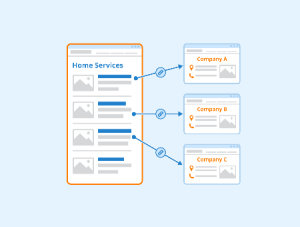
Exploring the 6 diiferent Types of SEO in Digital Marketing
Exploring the 6 diiferent Types of SEO in Digital Marketing In the vast landscape of digital marketing, understanding the diverse types of SEO in digital marketing is pivotal for online success. Search engine optimization (SEO) involves a plethora of strategies aimed at improving a website’s visibility on search engine result pages (SERPs), ultimately boosting organic traffic. Each type of SEO in digital marketing contributes to a comprehensive online marketing strategy, and in this article, we will delve into these various types to shed light on their significance. Photo by Brooke Lark on Unsplash Types of SEO in Digital Marketing: On-Page SEO On-page SEO, as one of the foundational types of SEO in digital marketing, revolves around optimizing individual web pages to enhance their search engine rankings and organic traffic. This type of SEO encompasses several elements, including: 1.1. Content Optimization: Effective content optimization involves creating high-quality, valuable, and relevant content that resonates with your target audience. Keywords, synonymous with “types of SEO in digital marketing,” must be strategically placed within the content. The integration of these keywords helps search engines understand the context and relevance of your content. 1.2. Meta Tags: Meta tags, such as title tags and meta descriptions, are essential on-page SEO elements. They provide concise descriptions of your webpage’s content, making it easier for search engines to display relevant information to users. 1.3. Header Tags: Proper use of header tags (H1, H2, H3, etc.) not only enhances the readability of your content but also provides structure and hierarchy to your webpages. Search engines use these tags to understand the content’s organization and importance. 1.4. URL Structure: A clean and descriptive URL structure can improve user experience and search engine ranking. URLs should be concise, contain relevant keywords, and convey the content’s subject. Types of SEO in Digital Marketing: Off-Page SEO Off-page SEO focuses on activities that occur outside of your website but still influence your online presence and rankings. This type of SEO is critical for building authority and trust in the digital realm. Key components of off-page SEO include: 2.1. Backlink Building: Backlinks, also known as inbound links, are links from other websites to yours. Acquiring high-quality backlinks from authoritative and relevant websites can significantly boost your SEO efforts. These backlinks serve as a vote of confidence in your content’s quality and relevance. 2.2. Social Media Engagement: Engaging with your audience on social media platforms is a crucial aspect of off-page SEO. Sharing content, interacting with followers, and building a strong social presence can drive traffic to your website and enhance your brand’s authority. 2.3. Online Reputation Management: Managing your online reputation involves monitoring what people say about your brand and addressing any negative feedback or reviews promptly. A positive online reputation can positively impact your search engine rankings. Types of SEO in Digital Marketing: Technical SEO Technical SEO deals with the technical aspects of website optimization, ensuring that search engines can crawl and index your site effectively. Key components of technical SEO include: 3.1. Site Speed: Page load speed is a vital ranking factor. Slow-loading websites can lead to higher bounce rates and decreased user satisfaction. Optimizing images, leveraging browser caching, and minimizing HTTP requests are some ways to improve site speed. 3.2. Mobile-Friendliness: With the increasing use of mobile devices, having a mobile-friendly website is essential. Google now prioritizes mobile-friendly websites in its rankings, making responsive design crucial for SEO. 3.3. Website Security: Ensuring the security of your website is not only important for user trust but also for SEO. Google prefers secure websites with HTTPS encryption, and unsecured sites may be penalized in rankings. 3.4. XML Sitemaps: XML sitemaps help search engines understand the structure of your website and index its pages efficiently. Creating and submitting an XML sitemap is a fundamental part of technical SEO. Types of SEO in Digital Marketing: Local SEO Local SEO is a specialized type of SEO focused on optimizing your online presence for local searches. This is particularly important for businesses with physical locations or those targeting specific geographical areas. Key elements of local SEO include: 4.1. Google My Business (GMB) Optimization: Claiming and optimizing your Google My Business listing is crucial for local SEO. It ensures your business appears in local search results, complete with essential information like address, phone number, and business hours. 4.2. Local Keywords: Incorporating location-specific keywords into your content and meta tags helps search engines understand your geographical relevance. For example, “types of SEO in digital marketing in New York” can attract local traffic. 4.3. Online Reviews: Online reviews and ratings play a significant role in local SEO. Encourage satisfied customers to leave positive reviews, and respond to negative feedback professionally and promptly. 4.4. NAP Citations: Consistency in your business’s name, address, and phone number (NAP) across various online directories and platforms helps boost your local SEO efforts. Types of SEO in Digital Marketing: E-commerce SEO E-commerce SEO is tailored for online stores and focuses on optimizing product listings and category pages. Some essential components of e-commerce SEO include: 5.1. Product Descriptions: Well-crafted product descriptions that include relevant keywords and address customer needs can improve your product pages’ search engine rankings. 5.2. Schema Markup: Using schema markup to provide additional information about products, such as ratings and prices, can enhance your search engine listings and attract more clicks. 5.3. User Reviews and Ratings: Customer reviews and ratings can boost trust and credibility, making potential customers more likely to purchase from your e-commerce site. 5.4. Product Image Optimization: Optimizing product images for both quality and speed can improve the user experience and SEO rankings. Types of SEO in Digital Marketing: Voice Search SEO As voice-activated devices and digital assistants become more popular, optimizing for voice search is gaining importance. Voice search SEO involves: 6.1. Conversational Keywords: Optimizing content for natural, conversational keywords that mimic how people speak can help capture voice search queries. 6.2. Featured Snippets: Featured snippets or “position zero” in search results are often targeted in voice search optimization. Providing
Exploring the 6 diiferent Types of SEO in Digital Marketing Read More »









